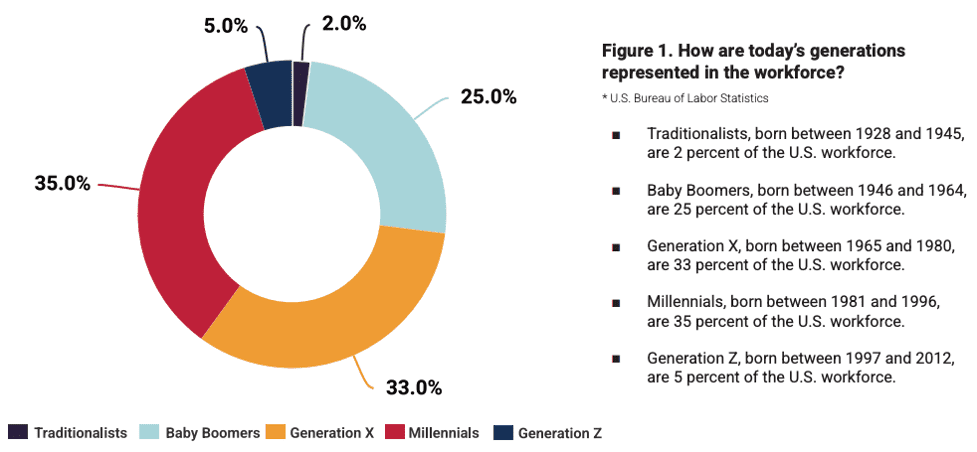We’re living through historic times. The events of the past few years – even the past few months – have been marked by volatility, uncertainty, anxiety and frustration. There have also been moments of resilience, hope and optimism. The shared experience of living through these unprecedented, historic events is what shapes generations and the current events will echo for generations to come.
There are currently five generations in the workplace (see Figure 1). Each generation was shaped by different events, and their experience informs their attitudes, values, beliefs and preferences. This can create challenges within an organization, especially when it comes to talent development. With five generations all working together, a one-size-fits-all approach for talent development is insufficient.
Talent leaders would benefit from a deeper understanding of the generational differences, and specifically the attitudes and expectations each generation holds about work to build a more effective plan for leadership development.

Understanding generational differences
How are the generations similar and where do they differ? Let’s break down each generation by exploring their preferred communication style, workplace attitudes and the tactics talent leaders can use to best develop their leadership skills.
Generation Z is the youngest generation in the workplace, and the largest generation on the planet, constituting more than 30 percent of the global population. Members of Gen Z are more racially and ethnically diverse than any previous generation and they value diversity and inclusion. They place a much lower value on salary compared to previous generations and prefer work that is interesting and mission-driven. Unlike their immediate predecessors, the Millennials, they prefer communication with colleagues face-to-face and by email. They expect greater flexibility and personalization as they advance through their career. To develop their leadership talent, employers should offer plenty of personalized development opportunities such as coaching and mentoring.
Millennials are the largest generation in the workforce today. They value flexibility, challenges, growth and development in their work environment. They’re attracted to organizations that offer a sense of purpose. They want to make a difference and feel valued for their work and ideas. Unlike Gen Z, they prefer text-based communications such as instant messaging and texts. Millennials grew up with social media. They appreciate teamwork and collaboration and they value relationships. They believe employers are responsible for preparing them for future leadership roles. To develop Millennials, HR leaders can provide social learning opportunities, whether they’re collaborating and connecting with peers, group coaching or mentoring. Talent development for Millennials should also focus on relevance and purpose, with practical skills connected to business impact.
Generation X, also known as the “Latchkey Generation,” values self-reliance, independence and flexibility. Above all, they strive for work-life balance. Caught between the two largest generations, Generation X has embraced communicating in whichever way is most efficient; they’re comfortable with text, phone or face-to-face meetings. The average Gen X leader has more than 20 years of work experience and they now account for most senior leadership roles globally. Talent development for Gen X should focus on flexibility and autonomy. Give them choices as to how and when they engage in learning and development, whether it’s self-paced learning opportunities or one-on-one coaching.
Baby Boomers witnessed the civil rights movement, women’s empowerment and the moon landing. They appreciate the value of goals, hard work and competition. “Boomers” believe in clear, hierarchical work structures, but they’re not afraid to challenge authority and the status quo. Baby Boomers expect transparency and democracy in decision making. They value face-to-face interaction and networking opportunities. Talent development for Baby Boomers should be goal-oriented and structured. Mentoring and reverse mentoring are useful practices to bridge the different generations and facilitate knowledge sharing.
Traditionalists, also known as the “Silent Generation” are the oldest generation in the workforce. They value safety, security and consistency. Traditionalists respect authority, hierarchy and a top-down chain of command. They prefer communication with personal touches, such as face-to-face interactions and handwritten notes instead of emails. When developing talent strategies for this generation, employers should explore ways to recognize and leverage their knowledge and experience and offer them opportunities to contribute.
Leadership development is now an expectation
The pandemic has shifted the worker-employer relationship in new and unexpected ways, challenging assumptions about remote work. A fiercely competitive labor market has raised the stakes for recruiting and retaining top talent. Investing in talent development and career growth is critical, especially for Millennials and Generation Z.
In a 2021 survey from technology firm Amdocs, when asked why they left or were considering leaving their jobs, 64 percent of respondents said it was due to a lack of job growth. Some 56 percent of respondents said they wanted more training and career development opportunities in 2022.
Millennials are not afraid to leave their jobs, especially if they lack leadership development opportunities which they perceive as essential to career growth. In fact, 2021 research from Great Place to Work found employees from this generation were four times more likely to intend to leave their work than Baby Boomers and 11 times more likely than Generation X.
Further, Millennials aren’t the only ones ready to leave unsatisfying roles. When Generation Zers were asked why they would leave their jobs, a 2021 survey from online resume maker Zety found that 47 percent would leave due to a toxic work environment and 43 percent would leave because of the inability to advance.
Every generation can benefit from leadership coaching
In Sounding Board’s 2022 webinar “Leadership Development For the Multigenerational Workforce,” Senior Behavioral Scientist Iyad Uakoub describes how a more people-centric leadership style can both humanize and optimize the multi-generational workplace. So, how can talent leaders humanize their leadership development strategies? Uakoub said developing adaptive or agile leaders is important, meaning leaders have the ability to adjust or flex their leadership style based on each generation’s needs and preferences.
Adaptive leaders ask more questions. They make fewer assumptions, collect data more frequently, lead with empathy and consistently seek to test and challenge their own assumptions. Cultivating agile leaders starts by empowering them with the knowledge they need to understand and practice agile behaviors. That’s where leadership coaching comes in. Coaching offers a personalized approach to a leader’s development that not only helps them build skills, but it also serves as a useful model for the agile leadership behaviors they want to develop.
Coaching helps retain leaders at all levels and creates a “halo effect” for those working with these leaders as they become better, more effective managers. A 2021 survey from software company GoodHire investigating reasons behind The Great Resignation found that Generation X, Millennials and Generation Z cited their boss as the top reason they left their jobs. Leadership coaching can help a bad boss become better and can transform a good boss into a great boss.
Coaching is no longer reserved for the most senior leaders in an organization. Technology has made it easier to manage, measure and scale coaching and organizations are using leadership coaching to develop leaders at all levels, representing every generation. Technology-enabled coaching also supports each generation’s preferences, whether they want leadership development that is more personalized, more flexible, more social, more face-to-face or more practical.












